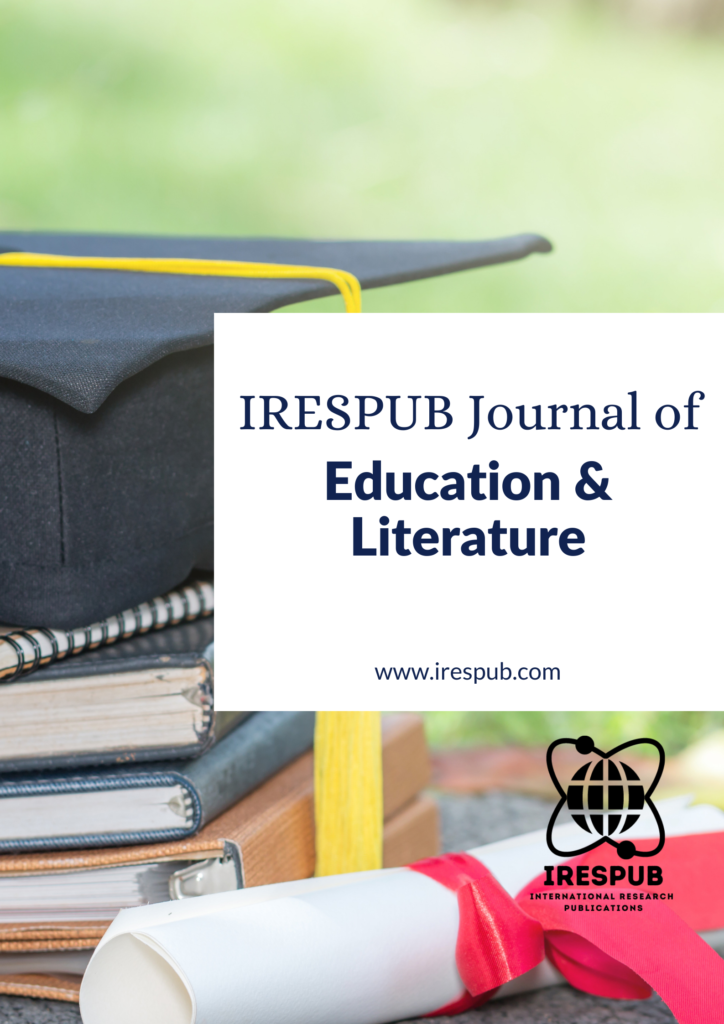
Year Launched: 2021
Journal Menu
- Scope & Research Areas
- Instructions for Authors
- Article Processing Charge
Journal List
- Natural & Applied Sciences
- Life Sciences
- Business Management
- Education & Literature
- Humanities & Cultural Studies
- Medical & Dental Sciences
- Engineering & Computer Sciences
- Agriculture, Food & Nutrition
- Environmental & Material Sciences
- Wellness & Lifestyle Management
- Arts & Ideas
- Law, Policy & Religion
Effect of Computer Assisted Instructions on Students’ Achievement in Damp Proofing Course Skills in Polytechnics in Anambra State
Volume 3, Issue 2, Mar-Apr 2024 | Page 12-18 | PDF (908K) | Pub. Date: April 24, 2024
Author(s)
Ekwelem Okechukwu1, Nnamdi J Onyili2 & Tochi Assumpta Obi3; 1University of Nigeria Nsukka; 2Department of Works and Services, Nwafor Orizu College of Education Nsugbe Anambra state; 3Department of Building, Faculty of Environmental science, Nnamdi Azikiwe University Awka, Anambra State
Abstract
The aim of the study is to explore the effect of computer assisted instructions on students’ acquisition of damp-proof course skills in Polytechnics in Anambra State. Specifically, the study determined the effect of computer assisted instructions on students’ acquisition of damp-proof course skills in building construction in Polytechnics in Anambra State. One objective, one research question and one hypothesis guided the study. The design of this study is a quasi-experimental design. The population for the study comprised 160 Ordinary Diploma Level II Building Technology students in the two Polytechnic in Anambra State which include: Federal Polytechnic, Oko and Anambra State Polytechnic, Mgbakwu. The instrument, lesson plans and the Table of specification/Test Blue Print were subjected to face and content validation by two experts. The instrument yielded a reliability index of .76. The data for the research question of this study was analyzed using mean and standard deviation. The hypothesis was tested at .05 level of significance using analysis of covariance (ANCOVA). The findings of the study revealed that students taught damp proof course skills using computer-assisted instruction (experimental group) had a higher achievement mean score when compared with those taught with chart/board (control group). The following recommendations were made based on the findings of the study: Computer assisted instructions should be adopted by curriculum designers and teachers as one of the participatory methods of teaching and learning of building technology in the Polytechnics. Lecturers should be trained and retrained by the government on how to use computer assisted instructions in order to improve students’ academic achievements.
Keywords
Computer-assisted instructions; building technology skills; damp proof course; polytechnics
Cite this paper
Okechukwu, E., Onyili, N. J., Obi, T. A. (2024), Effect of Computer Assisted Instructions on Students’ Achievement in Damp Proofing Course Skills in Polytechnics in Anambra State, IRESPUB Journal of Education & Literature. Volume 3, Issue 2, Mar-Apr 2024, Page 12-18
References
[1] Akinyele, T. A. & Bolarinwa, F. F. B. (2018). Prospects, Issues and Challenges of Technical and Vocational Education and Training (TVET) in Revamping Nigeria Depressed Economy. International Journal of Vocational and Technical Education Research. 4 (1), 1 – 18.
[2] Al-Bataineh, A., & Brooks, L. (2003). Challenges, advantages and disadvantages of instructional technology in the community college classroom. Community College Journal of Research and Practice, 27, 473-484.
[3] Atta, E. (2015). Impact of Computer Based Instruction (CBI) on Students’ Performance in Mathematics: A Case Study of Public Basic Schools in Kasoa. Unpublished Master’s Thesis. University of Cape Coast.
[4] Booker, D. (2012). Current Issues, Concerns, Challenges and Prospects for TVET and Education for the World of Work in the Asia Pacific Region. A Background Paper for Bonn International Centre for TVET Planning Meeting, Bangkok, May 20 – 25.
[5] Dewi, S. S. & Sudira, P., (2018) “The Contribution of Teaching Factory Program Implementation on Work Readiness of Vocational High School Students in Makassar,” Educ. Sci. Technol., 4 (2) 126–131.
[6] Fuchs, T., & Woessmann, I. (2004). “Computers and Student Learning: Bivariate and Multivariate Evidence on the Availability and Use of Computers at Home and at School”, CESifo Working Paper. No. 1321. November. Munich.
[7] Gopal, M. (2016). Damp proof course (DPC) – methods of dpc installation in construction (PDF). Available at: https://theconstructor.org. Accessed: 2/12/2022
[8] Hakksrinen, K. (2001). Teachers Information Communication Technology Skills and Practices of using ICT. Journal of Technology and Teacher Education.
[9] Hussaini, B. & Jumba, A. M. Y., (2018) “Opportunities and Challenges for Technical and Vocational Education and Training (TVET) in Nigeria”. Available at SSRN: https://ssrn.com/abstract=3194372.
[10] Julius, J. K. (2018). Influence of Computer Aided Instruction on Students’ Achievement, Self- Efficacy and Collaborative Skills in Chemistry in Secondary Schools of Tharaka-Nithi County, Kenya. Unpublished PhD Thesis. Kenyatta University.
[11] Laborde, C. (2002). Integration of Technology in the Design of Geometry tasks with Cabri– Geometry. International Journal of computers for Mathematical Learning.
[12] Mahmood, A., & Bokhari, N. H. (2012) Use of Information and Communication Technology: gender differences among students at tertiary level. Journal of Educational and Instructional Studies in the world November 2012, Volume: 2 Issue: 4 Article: 12 ISSN: 2146-7463.Available at http://www.wjeis.org/FileUpload/ds217232/File/12.mahmood.pdf
[13] McGrath, S. (2014). Revising the 2001 Revised Recommendation concerning Technical and Vocational Education Available at https://unevoc.unesco.org/home/Special%20Virtual%20Conference%20 Revising %20the%20Revised%20Recommendation%20-% 20Resources Accessed: 18/05/202
[14] Mogaji, J.O. (2019). Improvement needs of electrically electronics engineering national diploma curriculum in Nigeria Polytechnics. Unpublished Ph.D. Thesis, University of Nigeria, Nsukka.
[15] National Board for Technical Education. (2006). Curriculum and course specifications for HND in building technology. Kaduna: NBTE Press.
[16] NBTE (2001) Building Technology – Higher National Diploma (HND) Curriculum and Course Specifications Kaduna: National Board for Technical Education. Available at https://net.nbte.gov.ng/sites/default/ files /2018-12/HND%20Building%20Tech..pdf Accessed on 17/05/2020.
[17] NBTE (2020) List of polytechnics in Nigeria Available at: https://net.nbte.gov.ng/ Accessed: 14/08/2020.
[18] Nwogu, P. O. & Nwanoruo, C. C (2011). Vocational Technical Education and Training for Self-reliance: towards National Development. Mediterranean Journal of Social Sciences 2 (5) 55 – 59.
[19] Odu, K. O. (2011). Human capital development in science and technology education: challenges and new responsibilities for the teacher. Contemporary Educational Technology 2 (3) 238 – 249.
[20] Ojimba, D. P. (2012). “Vocational and Technical Education in Nigeria: Issues, Problems and Prospects” Dimensions. Journal of Education and Social Research 2 (9) 23 – 30.
[21] Paul, K. N. (2015). Preparedness of Public Secondary Schools on the use of Information Communication Technology in Teaching and Learning in Mukurweini, Nyeri County- Kenya. Kenyatta University: Unpublished Master’s Thesis.
[22] Polyguard (2021). What is damp proofing and when is it necessary? Available at: https://polyguardproducts.com. Accessed: 2/12/2022
[23] Richardson & Starling’s damp specialist (2019). Damp-Proofing specialist advice. Available at: https://www.richardsonandstarling.co.uk. Accessed: 2/12/2022
[24] Samphina Academy (2020) Polytechnics in Nigeria offering Building Technology. Available at: https://samphicom.ng/polytechnics-offering-building-technology-nigeria/ Accessed: 14/08/2020

